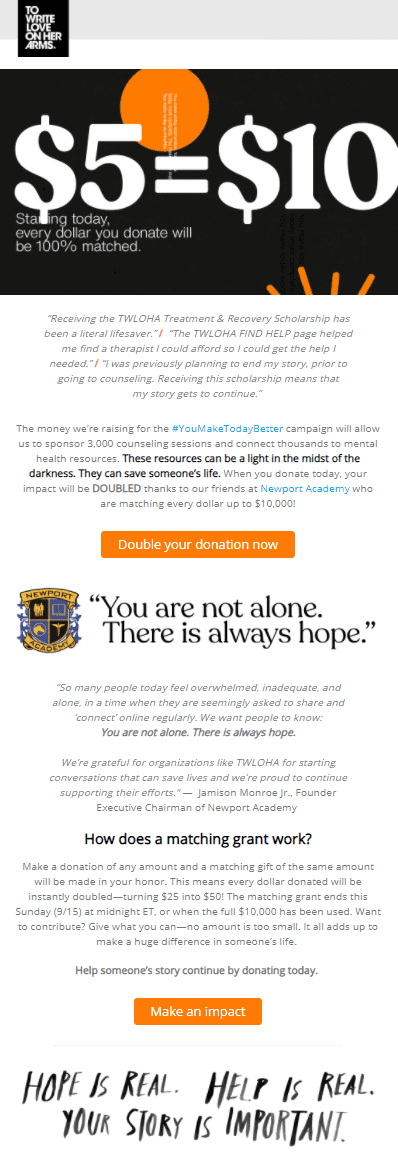12 Donation Match Best Practices to Supercharge Fundraising

This blog was written in collaboration with the team at Double the Donation, an online donation matching tool built to amplify nonprofit fundraising.
When resources are tight, social impact organizations have to make the most of every contribution. That’s where donation matching opportunities come in.
According to research from Double the Donation, 84% of donors are more likely to give if their contributions get matched, and one in three say they’d make a larger donation if a match were available.
In this guide, we’ll walk through our recommendations for maximizing a matching gift strategy, including the best matching gift sources and tried-and-true tips for success.
How to Source the Right Donation Match Partner
Maximizing a donation match starts with sourcing the right matching gift partners for your organization. Luckily, existing data can be one of your most valuable assets in identifying and pursuing matching gift opportunities—from employee matching gifts to major donation match challenges.
Just as software providers like Classy and Double the Donation use platform data to refine their tools, nonprofits should leverage first-party supporter data to enhance their engagement strategies. In this case, donor data can directly inform the types and sources of matching gifts you pursue.
Donation Match Structures
Understanding which donation match best suits your goals is essential. Here are a few of the most popular matching gift initiatives your organization might consider.
Employee Matching
With employee (or corporate) matching gift programs, companies match employees’ donations to nonprofit or educational causes. According to research from Double the Donation, nearly 27 million individuals work for over 24,000 companies that match donations.
Fundraising Matches
Through fundraising match programs, employees request funds for the donations they raise on behalf of a nonprofit organization. These initiatives often coincide with peer-to-peer fundraising campaigns, like run/walk/rides and other event-a-thon experiences.
For example, if a volunteer fundraiser collects $1,000 from their peers for a 5K charity run, they can request a match from their employer—even if they didn’t contribute to the funds.
Custom Matching Gift Programs
With a custom matching gift program, a company also matches its employees’ donations. However, it matches gifts only to a single nonprofit with an established partnership. These programs foster relationships between organizations, matching partners, and individual donors.
Donation Match Challenges
Through donation match challenges, a company, foundation, or major donor agrees to contribute a match up to or equal to the sum of the other donations collected within an established time frame. These initiatives incite urgency and often get organized in tangent with time-based efforts like Giving Tuesday.
Matching Grants
With matching grants, a type of donation provided by a company, foundation, individual, or government agency, the recipient collects a predetermined amount (typically equal to the match offer) in other donations.
For example, a Fortune 500 company might propose a generous donation of $10,000 to a nonprofit medical research center. However, the organization must first raise $10,000.
Donation Match Sources
Once you’ve honed in on the type of match you’ll offer, identify the funding source.
Corporations
Corporations can be some of your organization’s most valuable matching gift providers. For one, your team can encourage donors to request matches from their employers. Clear communication on the matching gift process—and ample resources to aid donors in advocating for new matching gift programs—encourages program participation and amplifies individual contributions.
However, companies may also consider funding a donation match challenge, matching grant, or other type of match. These initiatives supply organizations with invaluable match funding and inspire individual giving beyond a company’s workforce.
Small Businesses
A small business matching partner is typically a local or regional company in your geographic area. Consider nearby boutiques, accounting firms, grocery stores, service providers, restaurants, and more.
Because smaller businesses likely receive fewer sponsorship proposals, and you already have a shared interest in supporting your specific community, these match partners may be easier to reach. Plus, positive publicity can benefit the company’s bottom line and contribute to its corporate social responsibility (CSR) efforts.
Influencers
Influencers activate modern supporters.
In fact, our Why America Gives report shows that new generations of supporters are more than four times as likely to learn about—and get inspired to support—causes from influencers and celebrities than traditional donors.
Thanks to their widespread reach and significant online following, nonprofit influencers can ask their audiences to contribute to a match. Plus, if the influencer is also a devoted supporter of your cause, they may contribute their dollars, too.
To find the right partner, reach out to well-known individuals with connections to your organization’s mission. For example, if your nonprofit works with animals, look for an influencer who has demonstrated a love of furry friends in the past. They’ll be more inclined to accept your proposal and likely to have an audience that cares about your cause.
Major Donors
A major donor-funded match leverages a contribution from a highly generous supporter to amplify gifts from other individuals. To get started, use donor data and prospect research strategies to locate a donor willing and able to fund a match. Then, identify individuals who have contributed significant gifts in the past and determine if you have any underutilized major gift prospects in the funnel.
From there, implement highly personalized engagement strategies (such as face-to-face meetings or video chats) to pitch the idea of a donation match.
Board Members
A nonprofit’s board of directors often contains some of its most valuable donors, and these individuals are ideal prospects for funding a matching gift campaign. Many companies (such as the U.S. Bank, Autodesk, and Schneider Electric) even offer unique matching gift programs for board members with increased matching gift ratios, heightened donation maximums, and more.
Crowdfunding
Crowdfunding proves there’s strength in numbers.
While nonprofits often rely on a key contributor to put up a matching gift, sourcing high-value matches requires significant relationship-building and development team time. However, if your nonprofit doesn’t have the capacity to secure a match from a single donor, consider crowdsourcing your matching fund instead.
Crowdfunding allows your team to leverage multiple smaller or mid-level gifts to establish a match—even without a major donor.
To crowdsource a matching gift, you only need a powerful crowdfunding platform and a network of supporting donors to help fund your efforts. Then, get donors of all levels involved, including local businesses, corporations, influencers, and more.
Top Tips to Identify and Optimize Each Matching Gift Opportunity
For the greatest results, your team should take advantage of every donation match opportunity, regardless of its origin.
1. Identify Potential Match Funders
As you initiate the match-sourcing process, start by reviewing your relationships with major donors, corporate sponsors, local businesses, foundations, grantmaking institutions, and more.
Screening for existing matching gift companies using donors’ employment information can also shed light on other opportunities in your network.

Plus, a matching gift tool like Double the Donation (which integrates seamlessly with Classy’s platform) offers an excellent way to gather, organize, and leverage this data.
2. Tailor Your Matching Gift Proposal
As you propose matching gift opportunities to potential partners, tailor your pitch to each prospect according to their primary goals and objectives. Consider suggesting multiple match levels with incentives increasing based on the amount contributed.
Some matching donors may want public recognition, while others would rather avoid the spotlight. As a result, you might feature a corporation looking for a marketing boost on your website and campaign materials while framing an individual donor as a generous but anonymous matching partner.
3. Make Your Pitch
At this point, you have established the basis of your nonprofit’s elevator pitch. (Hint: You’ll want to include your mission statement, impact stories, data, and a description of your partnership’s added value.) Now, you’re ready to pitch your proposal.
Remember, use your relationships. See if anyone in your network can warmly introduce a new partner. Do you have a staff member who knows the owner of a local business? Does a committee leader work with an influencer you’d like to pitch? Leverage connections to grab the partner’s attention and build a strong foundation.
4. Amplify Giving Further with Multiple Matches
Matching gift funds aren’t generally mutually exclusive. To amplify donation impact, consider layering multiple matching gifts, such as an employee match on top of a challenge gift.
For example, imagine an individual donates $100 during a matching gift challenge, bringing the total value to $200. Afterward, the donor learns the gift also qualifies for a match from their employer. Upon submitting a request, the company matches the initial $100, which, in addition to the existing match, brings the total value to triple the initial gift.
5. Align Expectations with Your Match Partner
Before you announce your match campaign, have a clear agreement with the funding partner to help foster trust and transparency from the start. It essentially boils down to this:
- What does the partner expect from our nonprofit?
- What do we expect from our partner?
Be sure you’re on the same page regarding the limits, time frame, and other campaign criteria. Additionally, ensure a mutual understanding of what the money will support and the donor’s role in the campaign.
Smart Practices for Marketing Your Matching Gift Initiative
Once you’ve established your donation match, it’s time to promote the opportunity to your audience. Follow these steps to increase awareness and participation in your matching gift efforts.
1. Launch Your Campaign
With the terms set, it’s time to start connecting with potential supporters. First, email repeat donors, recurring givers, and active fundraisers. Let them know they’re the first to hear about the opportunity, encouraging them to get you on your way to maximizing the match.
From there, take your campaign to the wider community.
2. Tell Stories to Communicate Match Impact to Individual Donors
Donors who understand the impact of their gifts—and matches—are most likely to participate in your campaign. We recommend incorporating smart storytelling strategies to demonstrate tangible outcomes in your matching gift outreach.
For example, here’s a story a nonprofit animal charity might share:
“In the past year, our organization received $20,000 in matching gift funding, allowing the shelter to expand its facilities significantly. We can now take in twice as many furry friends, providing the care, love, and rehabilitation they need before finding their forever homes.”
3. Keep Your Donor Messaging Short and Sweet
Donors’ attention can be pulled in multiple directions at any time, so you’ll want to capture their interest quickly. Let supporters know they can always follow up with your team for more information about the matching campaign, but aim to keep your messaging short, sweet, and to the point.
4. Establish a Sense of Urgency
Matching gift campaigns are typically time-bound, creating a sense of urgency that motivates people to get involved. While supporters can contribute to your mission anytime, the matching aspect makes them feel their donations will have a greater impact, driving increased participation.
Luckily, establishing urgency can happen in a few ways, depending on the structure of your match. Here are a few examples:
- “A generous sponsor will double all gifts made in the next 24 hours! Give today to double your donation.”
- “A major donor is matching gifts up to $50,000. Donate now to get your gift matched before it’s gone!”
- “We’ve reached the halfway point of our matching gift! Give now to double your impact!”
- “Your recent donation likely still qualifies for a match from your employer. Click here to complete your request before the window closes.”
5. Highlight Your Match in Relevant Fundraising Appeals
For individual donors, mentioning a match in your fundraising outreach goes a long way. This allows you to communicate the giving opportunity, drive traffic to your campaign page, and inspire excitement regarding the match.
Your appeal demonstrates why supporters should navigate to your donation website. Use the email to explain how your matching fund works, explain eligibility requirements, include impact-focused testimonials, and tap into the emotional hooks of your mission.
One example of an impactful matching gift email from To Write Love On Her Arms promoted a $10,000 donation match campaign in partnership with Newport Academy.

The appeal has an eye-catching graphic at the top to draw the reader in and highlight the dollar-for-dollar match. It shares quotes from real people who have benefitted from TWLOHA’s work to demonstrate the nonprofit’s impact. Then, it introduces the match with additional context while moving the reader toward a bright orange Double Your Donation Now button.
6. Market Your Match at the Point of Donation
Once a match gets established, your nonprofit must clearly market the matching gift opportunity to your audience. Your campaign page is one of the best places to start, allowing you to integrate matching gifts directly into the online giving experience.
Regardless of the primary match type, we recommend collecting mid-donation employment data to screen for corporate match-eligible transactions. It can be as easy as adding an employer search tool to your giving form, which empowers donors to check their eligibility and pursue a corporate match, if available.
7. Follow Up for Future Success with Intentional Stewardship
With a matching campaign, your follow-up process is twofold. First, acknowledge and thank donors for their participation. Later, share impact stories and other updates that illustrate the progress their gifts helped make.
Always remember to thank your match suppliers, too. The matcher is clearly invested in your cause, so take special care to keep them engaged and excited about your work.
Consider also reviewing the overall success of your campaign. Which communication channels or messages sparked the most engagement? Did this matching campaign attract particular segments of your donor base? Record conclusions and lessons learned to improve your next matching campaign.
Harnessing the Power of a Donation Match
A donation match is a win-win-win for every stakeholder involved. As a nonprofit, your donors feel empowered by their amplified impact, your team receives additional revenue, and your community is more engaged.
Whether you leverage a major gift, crowdsource a matching fund, encourage corporate matching gift participation, or use a combination of the three, expect to see transformative results for your organization.
Copy Editor: Ayanna Julien

Uncover Corporate Partnership Opportunities with Your Nonprofit Data



